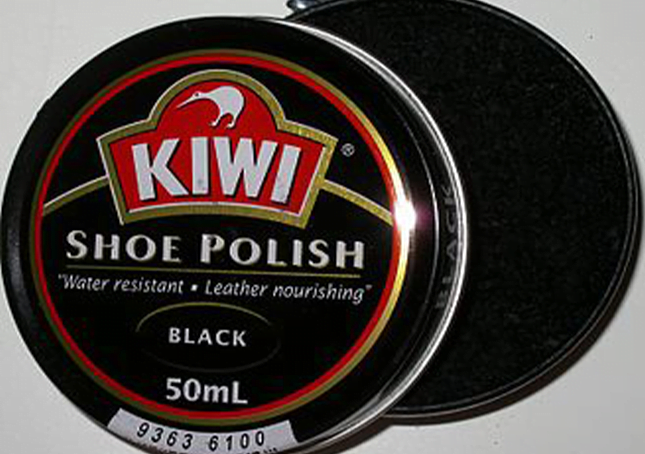Shoe polish

Shoe polish (or boot polish) is a waxy paste, cream, or liquid used to polish, shine, and waterproof leather shoes or boots to extend the footwear’s life and restore, maintain and improve their appearance. Shoe polishes are distinguished by their textures, which range from liquids to hard waxes. Solvent, waxes, and colorants comprise most shoe polishes.
Shoe polish can be classified into three types: wax, cream-emulsion, and liquid. Each differs in detailed composition but all consist of a mixture of waxes, solvent, and dyes.
Waxes, organic solvents and dyes compose this type of polish. Waxes are 20–40% of the material. Natural waxes include carnauba and montan as well as synthetic waxes. The composition determines the hardness and polishing properties after solvent has evaporated.
Solvents are selected to match the waxes. About 70% of shoe polish is solvent. A variety of solvents are used including naphtha. Turpentine, although more expensive, is favored for its “shoe polish odor”. Dyes make up the final 2–3% of the polish. A traditional dye is nigrosine, but other dyes (including azo dyes) and pigments are used for oxblood, cordovan, and brown polishes.
Owing to its high content of volatile solvents, wax-based shoe polish hardens after application, while retaining its gloss. Poorly blended polishes are known to suffer from blooming, evidenced by the appearance of a white coating of stearin on the polish surface.
These polishes may have a gelatinous consistency. They are composed of the usual three components waxes, liquid vehicle, and dyes. Unlike wax-based shoe polishes, cream-emulsions contain water and/or oil plus a solvent (either naphtha, turpentine or Stoddard Solution), so the liquid content is high. Emulsifiers and surfactants are required. These include ammonia, morpholine and various ethoxylated surfactants such as polysorbate 80. The waxes are often some mixture of carnauba wax, beeswax, montan wax and its oxidized derivatives, and paraffin waxes.
Liquid shoe polish is sold in a squeezable plastic bottle, with a small sponge applicator at the end. To decrease its viscosity, bottled polish usually has a very low wax content. Liquid shoe polish is a complex mixture. Polyethylene wax emulsion is a major component. Various polymers, typically acrylates, are the next major component, conferring gloss and holding the dyes in suspension. Resins and casein are selected to ensure adhesion to the leather. Fatty phosphate esters, emulsifiers, and glycols are also used. Pigments include titanium dioxide for whites and iron oxides for browns. Although liquid polish can put a fast shine on shoes, many experts warn against its long-term use because it can cause the leather to dry out and crack.
